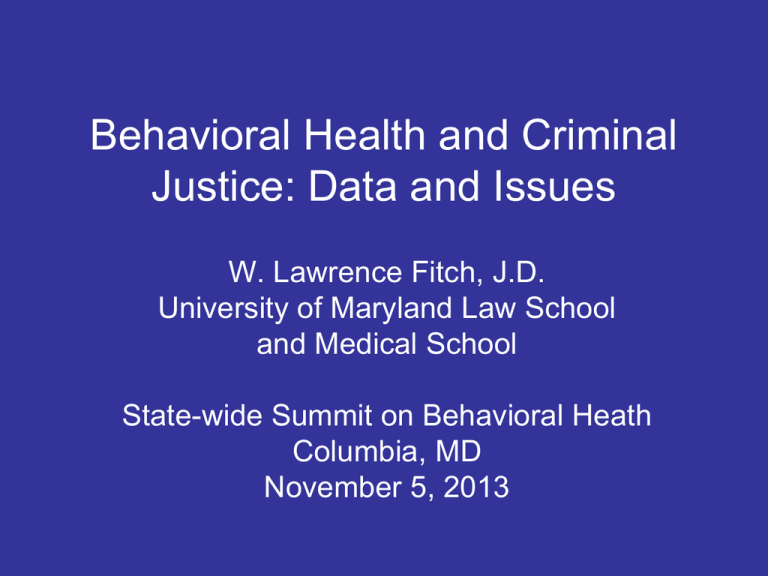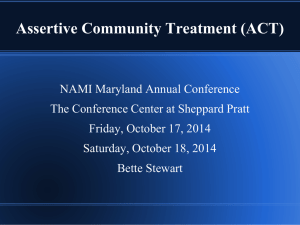
Behavioral Health and Criminal
Justice: Data and Issues
W. Lawrence Fitch, J.D.
University of Maryland Law School
and Medical School
State-wide Summit on Behavioral Heath
Columbia, MD
November 5, 2013
Evolution of Forensic Services (U.S.)
Pre-1970’s
•Security Hospitals in Remote Settings
•Lifetime Commitment
1980’s
•ABA Criminal Justice/Mental Health Standards
•Growing Professionalism
-University Programs
-Fellowship Training Programs
-Evaluator Training
-Research
-NASMHPD
1980’s, cont.
• Systems Changes
-Structured Evaluations
-Outpatient Evaluations
-Forensic Review Boards
-Conditional Release
-”Dangerousness” Studies (Monahan)
• Impact of Hinckley
-Tightening of Insanity Defense Criteria
-Restrictions on Expert Testimony
-Abolition of Insanity Defense (4 States)
-Advent of Guilty But Mentally Ill Laws
1990’s
• Risk Assessment Technologies
• Sex Offender Commitment Laws
• Systems Refinement, Development of
Community Forensic Services (Jails, CMHC’s)
2000’s
• Broadening the Scope of Forensic Services
• GAINS Center
• Criminal Justice/Mental Health Consensus
Project; Council of State Gov’ts Justice Center
Parenthetical: Actuarial Risk Assessment
• All the Rage
• The Bright Side
-Evidence Based (Product of Studies)
-Exposes False Assumptions
-Informs Aftercare Planning (Hawkes v State of MD, 2013), but…
• The Dark Side (Misuse)
-Influencing Commitment/Release Decision-making
>>Role of “Dangerousness” in MH Law
>>Relevance of Dangerousness Unrelated to Serious MI
>>Bastardization of Civil Commitment
-Quantifying Risk Without Regard For Containment
Measures
Broadening of Forensic
Services
Incarceration Trends in the U.S. (DOJ)
Jails and Prisons
Prisons Alone
1980
503,586
1972
196,092
1990
1,148,702
1982
394,374
2009
2,297,400
Jails Alone 2012
886,947
1992
846,277
2009
1,617,478
Number of Patients in State Psychiatric
Hospitals
1955
559,000
1995
69,000
1983
132,000
Today
< 43,000
Forces Driving Deinstitutionalization
• Advent of Effective Medications (1950’s)
• Community Mental Health Act (1963)
• Civil Rights Reforms: lawsuits over poor care;
stricter commitment laws (1960’s, 1970’s)
• Cost of Care: meeting heightened standards,
Medicaid reforms/ IMD rule
• Use of Private Facilities for Some Public Patients;
Managed Care
Prevalence of Serious Mental Illness in U.S.
Jails (Psychiatric Services, June 2009)
• Men: 14.5%
• Women: 31%
• Overall: 16.9%
Note: Inmates in this study did not necessarily have symptoms
suggesting a need for hospitalization (Osher, personal
communication, 2009); 72% have co-occurring substance
use disorders
Note: Mental illnesses range in severity: 26% of general
population has a MI; 6% has a serious MI (NIMH)
Note: Survey found 7.5% with a serious MI in Maryland jails;
an additional11.5% had a diagnosable mental disorder,
including personality disorders (HB 990 Report, 2007)
Query: Is the Prevalence of MI in
Jails Up? Or Are We Just Paying
Closer Attention?
• Very little earlier data– public indifference
• Case of Russell Weston (1998): “Failure of
the Mental Health System!” (Media)
• First DOJ study of MI in jails and prisons
(1998): “Transinstitutionalization!” (Media)
Public Response: Call for Enhanced
Services
• Council of State Governments Criminal
Justice/Mental Health National Consensus
Project (2002 Report, Ongoing Work)
• SAMHSA Funding for Jail Diversion Programs
(GAINS Center)
• Mentally Ill Offender Treatment and Crime
Reduction Act
• Intervention at Every Opportunity
Sequential Intercepts
Best Clinical Practices: The Ultimate Intercept
I. Law Enforcement/Emergency Services
II. Post-Arrest:
Initial Detention/Initial Hearings
III. Post-Initial Hearings:
Jail/Prison, Courts, Forensic
Evaluations & Forensic Commitments
IV. Re-Entry From Jails,
State Prisons, &
Forensic Hospitalization
Munetz, M. & Griffin, P. (2006). A systemic approach to
the de-criminalization of people with serious mental
illness: The Sequential Intercept Model. Psychiatric
Services, 57, 544-549.
V. Community
Corrections &
Community
Support
MENTAL HEALTH SERVICES FOR INDIVIDUALS
IN MARYLAND’S CRIMINAL JUSTICE SYSTEM
CRIMINAL ACT
BOOKING
JAIL
PRETRIAL
EVALUATION
CRISIS RESPONSE
Emergency Petition
Hospitalization
DIVERSION
Competent
to Stand Trial
INCOMPETENT
TO STAND TRIAL
TRIAL
NCR
NOT
GUILTY
GUILTY
PROBATION
TREATMENT
PRESENTENCE
EVALUATIONS
DHMH
FACILITY
JAIL
CONDITIONAL
RELEASE
UNRESTORABLE
DPSCS
PAROLE
RELEASE
RELEASE
RELEASE
RELEASE
MENTAL HEALTH &
OTHER SERVICES
How Are We Doing? Maryland Gets a
C- for “Diversion” (TAC, 2013)
• Study examined % of the population served
by a diversion program
• But the only diversion programs considered
were police-based crisis intervention teams
(CIT) and mental health courts
• Maryland has so much more
Broad Scope of Forensic Services in
Maryland (Beyond Competency and
Criminal Responsibility)
•
•
•
•
Police Training; Crisis Intervention Teams
Crisis Response Services
Jail-Based Services (MCCJTP– 22 Counties)
Forensic Alternative Services Team (FAST– Baltimore
City)
• Shelter Plus Care (20 counties)
• Court Diversion Evaluations
• Mental Health Courts
• Sentencing Options (Eval/Tx)
• Hospitalization of Inmates (Civil Commitment)
• Re-Entry (Meds, Referrals)
What Works: Elements of an Effective CommunityBased Forensic Treatment Program (GAINS, 2009)
• Housing
• Case Management
• Accessible Medications
• Peer Support
• Integrated Co-occurring Treatment
• Supported Employment
• Cognitive Behavioral Interventions (Targeting
Criminogenic Risk Factors)– Relapse Prevention
What Doesn’t Work:
Traditional Psychiatric Treatment Alone
• Recent studies show that changes in psychiatric symptoms
alone have little or no effect on likelihood of re-arrest:
H Steadman (2009); J Skeem (2010, 2011, 2013)
• Consistent with J Junginger’s finding that psychiatric
symptoms rarely drive criminal behavior (2006)
• Consistent with MacArthur Research Network’s finding that
serious mental illness (even delusions) not a statistical risk
factor for violence, absent substance use (1998 to date)
• More important factors: poverty, homelessness,
joblessness/ inactivity, family discord, substance use,
criminal history, antisocial behavior/ attitudes/ associates
Impact of SAMHSA Jail Diversion Programs
(2009)
• If the right services and supports are in place, arrest
rates fall by 50% in the first 12 months– recent
development, reflecting improved programs; earlier
studies showed little impact
• Costs to state of diversion higher in first year-- spread
among agencies: significantly higher to MH agencies,
lower to CJ agencies
• Research suggests state costs may fall after 18 months-but only because federal share of Medicaid coves some
of the costs
• Whether or not diversion saves money, all agree:
It’s the right thing to do!
Ongoing Reform Efforts
• Mental Health Criminal Justice Partnership
• Interagency Forensic Services Committee of the
Maryland Advisory Council
• Task Force on Prisoner Re-entry
• Local MH/ Criminal Justice Committees
Guns
Gun Laws and Mental Disorder: Federal Law
Gun Control Act of 1968 prohibits firearms and
ammunition to any person who has been
“adjudicated as a mental defective” or
“committed to any mental institution”
Gun Laws and Mental Disorder:
Maryland Law (Effective 10/1/13)
Person Ineligible to Possess Gun if:
(1)Has a mental disorder and history of violence
to self or others
(2)Has ever been adjudicated IST or NCR
(3)Has ever been involuntarily committed
(4)Has ever been voluntarily admitted for > 30
consecutive days
(5)Is under a court-ordered guardianship
(unless solely as result of physical disability)
Gun Laws and Mental Disorder:
Maryland Law (Effective 10/1/13), Cont.
If person civilly committed and hearing
officer finds that person “cannot safely
possess a firearm based on credible
evidence of dangerousness to others,”
court will order person to surrender
weapons and order person to refrain from
possessing a weapon unless person
relieved of disqualification by process
below
Gun Laws and Mental Disorder:
Maryland Law (Effective 10/1/13), Cont
• Person disqualified to possess gun for reasons
above (relating to mental disability) may apply to
DHMH for relief from disqualification
• Application must include 3 signed statements re
person’s character and reputation relevant to
firearm possession and a certificate from a Boardcertified psychiatrist or psychologist stating;
– length of time person free of symptoms making person
dangerous
– Length of time person compliant with treatment
– Opinion whether person , because of MI, would be dangerous
to self or others if allowed to possess a firearm, and reasons
for the opinion
Gun Laws and Mental Disorder:
Maryland Law (Effective 10/1/13), Cont
• Person must prove by a preponderance of the
evidence that he or she “unlikely to act in a
manner dangerous to the applicant or to public
safety and that [relieving the disqualification]
would not be contrary to the public interest”
• DHMH decides; person may appeal for hearing
and judicial review
• Psychiatrists and psychologists who act “in good
faith and with reasonable grounds” immune from
civil and criminal liability under this law
Confidentiality
• General Rule of Confidentiality in Maryland Law
and in HIPAA: Keep “medical record”/ “protected
health information” confidential (Health General
§ 4-302; Health General § 7-1010; HIPAA
Privacy Rule, 45 CFR Parts 160 and 164)
• Many exceptions to confidentiality: patient
consent, to arrange patient’s hospitalization, to
get paid, if sued by patient, if patient puts mental
state at issue in legal case, if patient has abused
a minor, if patient has infectious disease, if
patient suffers gunshot wound, if patient
threatens harm to another
Early Duty to Protect Case: Tarasoff
v Regents of the Univ of CA (CA
Supreme Court, 1976)
"The public policy favoring protection of
the confidential character of patientpsychotherapist communications must
yield to the extent to which disclosure is
essential to avert danger to others. The
protective privilege ends where the
public peril begins."
Maryland Law: Courts and Judicial
Proceedings §5-609
A cause of action or disciplinary action may not
arise against any mental health care provider or
administrator for failing to predict, warn of, or
take precautions to provide protection from a
patient’s violent behavior unless the mental
health care provider or administrator knew of the
patient’s propensity for violence and the patient
indicated to the mental health care provider or
administrator, by speech, conduct, or writing, of
the patient’s intention to inflict imminent physical
injury upon a specified victim or group of victims.
Courts and Judicial Proceedings §5-609), Cont.
Duty discharged if mental health provider or
administrator makes reasonable and timely efforts to:
(i) Seek civil commitment of the patient;
(ii) Formulate diagnosis and establish and undertake
documented treatment plan calculated to eliminate
the possibility that patient will carry out the threat; or
(iii) Inform law enforcement and, if feasible, the
specified victim or victims of:
1. The nature of the threat;
2. The identity of the patient making the threat;
and
3. The identity of the specified victim or victims.
Courts and Judicial Proceedings §5609), Cont.
No cause of action or disciplinary action
may arise under any patient confidentiality
act against a mental health care provider
or administrator for confidences disclosed
or not disclosed in good faith to third
parties in an effort to discharge a duty
arising under this section
But What About HIPAA?
45 CFR § 164.512
A covered entity may, consistent with applicable
law and standards of ethical conduct, use or
disclose protected health information, if the
covered entity, in good faith, believes the use or
disclosure: … (A) Is necessary to prevent or
lessen a serious and imminent threat to the
health or safety of a person or the public; and
(B) Is to a person or persons reasonably able to
prevent or lessen the threat, including the target
of the threat.
HIPAA, Cont.
• A covered entity… is presumed to have
acted in good faith …if the belief is based
upon the covered entity's actual
knowledge or in reliance on a credible
representation by a person with apparent
knowledge or authority
• January 15, 2013 letter from DHHS Office
of Civil Rights offers assurances
For Copies of Slides or Further
Information:
fitchwillard@gmail.com








